1 of 13
Downloaded 19 times
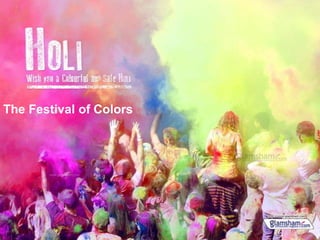

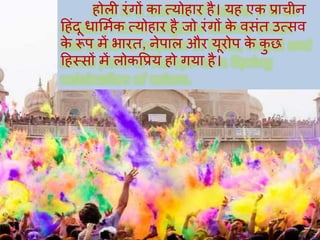
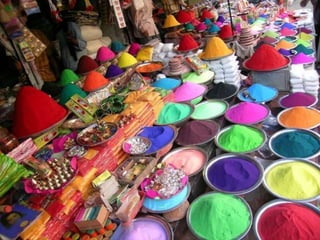
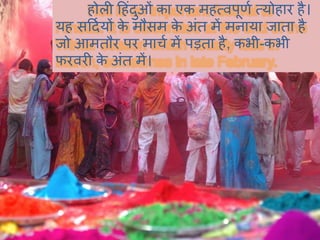
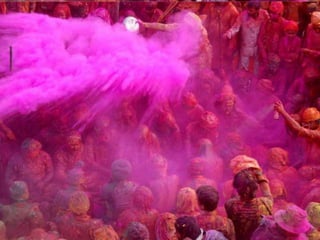
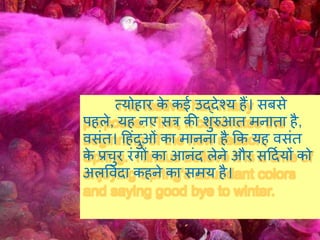

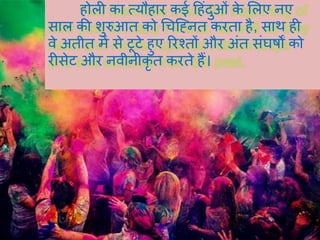



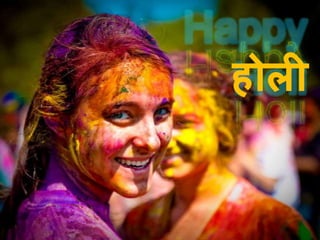
Ad
Recommended
Diwali festival of lights (hindi)
Diwali festival of lights (hindi)Martin M Flynn
╠²
an introcuction to the Hindu Festival of the Lights, in the context of ecumenism and world peace - ÓżÅÓżĢÓżżÓżŠÓżĄÓżŠÓż” ÓżöÓż░ ÓżĄÓż┐ÓżČÓźŹÓżĄ ÓżČÓżŠÓżéÓżżÓż┐ ÓżĢÓźć ÓżĖÓżéÓż”Óż░ÓźŹÓżŁ Óż«ÓźćÓżé Óż░ÓźŗÓżČÓż©ÓźĆ ÓżĢÓźć Óż╣Óż┐ÓżéÓż”Óźé ÓżżÓźŹÓż»ÓźŗÓż╣ÓżŠÓż░ ÓżĢÓźć Óż▓Óż┐ÓżÅ ÓżÅÓżĢ Óż¬Óż░Óż┐ÓżÜÓż» -Presentation -INDIA.ppt.pdf for India country
Presentation -INDIA.ppt.pdf for India countryRahulKumar307015
╠²
This document provides an overview of India, beginning with a description of its name, history, and geography. It then discusses India's constitution, government, leaders, cultural symbols, ethnic and religious diversity, languages, art forms, natural resources, agriculture, and literacy rates. It also features sections focused on Kerala and Kasaragod that describe these regions as popular tourist destinations known for their beaches, hills, fortresses, and religious sites. The document aims to convey India's rich past and diverse cultural heritage through its political, geographic, demographic, and artistic aspects.Harvest Festival Baisakhi 2016 Date, Significance & Celebrations in Punjab, I...
Harvest Festival Baisakhi 2016 Date, Significance & Celebrations in Punjab, I...Journeymart.com
╠²
Baisakhi is a spring harvest festival celebrated in Punjab on April 13th each year. It marks the traditional start of the harvest season and is celebrated by Sikhs and Hindus with dancing, visiting gurdwaras, and expressing gratitude to God for the harvest. For Sikhs, Baisakhi commemorates the founding of the Khalsa brotherhood in 1699.Welcome to india
Welcome to indiaDokka Srinivasu
╠²
India is a land of rich cultural heritage with diverse languages, religions, and ethnic groups. It has a long history and is known for its epics like the Ramayana and Mahabharata. Rajasthan is India's largest state, known as the "Great Indian Desert." Jaipur, the pink city, was the first planned city in India and is famous for its monuments like Hawa Mahal and Amber Fort. Jaipur hosts colorful festivals celebrating local culture and traditions.PPT on festivals
PPT on festivalsdeepak walia
╠²
India celebrates a wide variety of festivals throughout the year that showcase its rich culture and traditions. Some of the most popular festivals celebrated in India are Diwali, Dussehra, Janmashtami, Ganesh Chaturthi, Holi, Gurupurab, and Raksha Bandhan. Diwali, also known as the Festival of Lights, is a five-day festival that honors the victory of good over evil and is celebrated with fireworks, lamps, and candles to commemorate Lord Ram's defeat of the demon Ravana and rescue of his wife Sita.Uttarakhand culture-ppt
Uttarakhand culture-pptStupidityStudy
╠²
Uttarakhand, located in northern India, is known as the "Land of the Gods" due to its many Hindu temples. The state has 13 districts divided between the Kumaon and Garhwal divisions. Some key aspects of Uttarakhand culture discussed in the document include the languages of Kumaoni and Garhwali, folk songs and dances, traditional cuisine, arts such as Aipan murals, and festivals like Makar Sankranti and Basant Panchami.Diwali
DiwaliAmisha Kumari
╠²
Diwali is celebrated by Indians across the globe as the "Festival of Light," commemorating the return of the mythological king Rama to Ayodhya after defeating the demon king Ravana. Diwali involves wearing new clothes, lighting lamps and fireworks, exchanging gifts, and worshipping the goddess Lakshmi. The five-day celebration includes Dhanteras, Chhoti Diwali, Lakshmi Puja, Govardhan Puja, and Bhai Dooj. The document discusses plans for celebrating Diwali at an organization, including decorating, holding competitions, wearing traditional attire, serving Indian cuisine, and everyone playing a role to make it a success.15th August
15th Augustpvrsrpvarma ....
╠²
The document summarizes India's Independence Day, which is celebrated annually on August 15th. It marks the day in 1947 when India gained independence from British colonial rule after nearly a century of struggle. Independence Day celebrations involve hoisting the Indian flag, listening to speeches by leaders, and remembering the sacrifices made by freedom fighters. It is an occasion for Indians to renew their hopes and dreams for the nation while also paying tribute to those who fought for their freedom.FESTIVALS OF INDIA
FESTIVALS OF INDIABhavika Vallecha
╠²
India celebrates many festivals that depict its diverse culture and traditions, including Diwali, Dussehra, Independence Day, Republic Day, Gandhi Jayanti, Holi, Raksha Bandhan, and Eid Mubarak. Diwali honors the victory of good over evil and is celebrated through lights and fireworks. Dussehra commemorates Lord Rama's victory over Ravana. Independence Day and Republic Day celebrate India's independence and status as a republic. Gandhi Jayanti honors the leader Mahatma Gandhi. Holi is a festival of colors. Raksha Bandhan celebrates the bond between siblings. Eid Mubarak marks the end of Ramadan for Muslims.The Festivals Of India
The Festivals Of IndiaDevang Gupta
╠²
Festivals in India are categorized into national, religious, and harvest festivals. National festivals like Independence Day, Republic Day, and Gandhi Jayanti celebrate the unity and history of the nation, while religious festivals such as Diwali, Holi, and Christmas commemorate various cultural and spiritual traditions. Harvest festivals like Bihu, Pongal, and Baisakhi signify the importance of agriculture and seasonal change across different regions.Holi ppt
Holi pptSonel Tomar
╠²
Holi is an ancient Hindu festival that originated in India and is celebrated mainly in North and East India. The festival celebrates the victory of good over evil and commemorates various legends, including the demoness Holika's plan to kill Prahlad being foiled when she herself was burned but Prahlad was saved by his devotion to Lord Vishnu. The main celebrations of Holi include lighting bonfires on the eve of Holi to commemorate Holika's burning, and applying colored powders and water to each other the following day.Sri Aurobindo
Sri Aurobindo Surya Pratap Singh Rajawat
╠²
Sri Aurobindo was born in 1872 in India but spent his childhood and youth in England where he studied before returning to India in 1893. He became involved in the Indian independence movement and was imprisoned for one year. After his release he shifted his focus from politics to spirituality and yoga. He moved to Pondicherry in 1910 where he established an ashram and continued his spiritual work with The Mother, publishing many influential writings. Sri Aurobindo passed away in 1950 but his teachings on integral yoga and vision of human progress continue guiding his ashram.Festivals of India
Festivals of IndiaNeetha Joseph
╠²
India is a land rich in culture and traditions, known for its numerous festivals and fairs celebrated throughout the year. Major festivals include Diwali, a five-day Hindu festival known as the Festival of Lights; Holi, a vibrant festival of colors; and regional celebrations like Bihu in Assam and Pongal in Tamil Nadu, each with unique customs and significance. These festivals foster unity and community spirit, bringing together people from diverse backgrounds to celebrate joy and tradition.Holi
Holipramodyadav
╠²
Holi is a popular Hindu spring festival celebrated in many countries. It usually falls in late February or early March. The festival commemorates various stories from Hindu mythology and marks the arrival of spring. It is celebrated by throwing colored powders and spraying colored water on friends and family. The main day of festivities involves people participating in raucous behavior by singing, dancing, and drinking bhang.Happy Independence day { PPT }
Happy Independence day { PPT }shivamsahu906548
╠²
This PowerPoint presentation summarizes key information about India's Independence Day, which is celebrated annually on August 15th. It discusses the history of India's independence movement from British rule, led by prominent figures like Mahatma Gandhi, Jawaharlal Nehru, and Sardar Vallabhbhai Patel. It also outlines how Independence Day is commemorated through flag hoisting ceremonies, cultural events, and school celebrations, to pay tribute to the country's freedom fighters and rich heritage.Presentation on Holi
Presentation on HoliPonmathi Singhania
╠²
The document discusses the Holi festival in India. Holi is a Hindu festival celebrated in spring that symbolizes the victory of good over evil. It originated from the story of the demon king Hiranyakashipu and his daughter Holika. People celebrate Holi by throwing colored powders and water at each other, dancing, singing, and enjoying festive foods. Some popular places to celebrate Holi in India include Mathura, Delhi, Shantiniketan, and Jaipur.GEOGRAPHY OF INDIA
GEOGRAPHY OF INDIAabhishekprabhukumar
╠²
India has significant geographical diversity due to its large size and location in South Asia. It spans a wide range of landscapes from the Himalayan mountains in the north to the Thar Desert in the west. Major rivers like the Ganges and Indus flow from the Himalayas across fertile plains, influencing settlement patterns and supporting agriculture. India experiences distinct seasonal changes including a summer monsoon season that is crucial for crop growth. This diversity of terrain and climate has endowed India with valuable natural resources but also environmental challenges like floods and droughts.presentation on diwali by shweta
presentation on diwali by shwetaShweta Verma
╠²
The document discusses the history and traditions of the Hindu festival of Diwali. It explains that Diwali, also known as the "Festival of Lights", commemorates the return of Lord Rama to his hometown of Ayodhya after defeating the demon Ravana. It is traditionally celebrated through lighting candles, diyas, fireworks and sparklers to welcome Lord Rama. The lighting symbolizes the victory of good over evil. [/SUMMARY]Deepavali Presentation Diwali Presentation
Deepavali Presentation Diwali PresentationSrinivas Shakelly
╠²
The document discusses the Hindu festival of Diwali. It is a festival of lights celebrated by Hindus, Jains, Sikhs, and some Buddhists. It falls towards the end of the Hindu month of Ashwin and lasts for five days. On each day, people light lamps to symbolize the victory of light over darkness and good over evil. Diwali commemorates different historical and religious events depending on the faith, such as the return of Lord Rama after defeating Ravana or the release of the Sikh Guru Hargobind from imprisonment. Common Diwali activities include worshipping the goddess Lakshmi for prosperity, drawing colorful rangoli patterns, lighting lamps, sharing sweets, and spendingNavratri
NavratriRashmi Priyem Saravanan
╠²
Navratri is one of the longest celebrated Hindu festivals. In South India, it is celebrated for nine days following the new moon day in September-October. Nine forms of the goddess Shakti are worshipped over nine days. Special prayers are offered for health and prosperity. People fast and wear colorful costumes while performing garba and dandiya dances. In Madurai, the Meenakshi Amman Temple is decorated with lights and dolls are displayed in kolu exhibits with themes representing deities, saints, and social activities.Pongal
PongalBotany Downs School
╠²
Pongal is a four-day harvest festival celebrated in Tamil Nadu, India in mid-January. The first day involves dancing around bonfires. The second day is the main festival day where rice pudding is cooked at sunrise and people wear new clothes. The third day thanks cows for their role in farming, and the fourth day involves family reunions and gifts between brothers and sisters and landlords and tenants. Traditional kolam designs are drawn outside homes using rice flour.Indian culture
Indian culturerishi229225111
╠²
Culture can be defined as the refinement of the mind, tastes, and manners of a group of people. It is connected to the behaviors, moral values, and human relations within a society. Some aspects of Indian culture discussed in the document include religions such as Hinduism, Sikhism, Islam, Jainism, and Buddhism. Folk music genres like Sufi songs and gazals are also part of Indian culture. Classical and folk dances as well as popular dances are discussed. Major festivals celebrated in India by different religious communities are also outlined.Festivals of india
Festivals of indiaJoyoson Mathai
╠²
Indian festivals are celebrated by different cultures through special rituals and add color to Indian heritage. They welcome seasons, harvests, rains or full moons, or celebrate religious occasions. Many festivals celebrate different harvests or commemorate historical figures and events, while expressing devotion to various deities. Festivals emphasize different aspects in different parts of India. They include Durga Puja, Dasehra, Diwali, Kali Puja, Raksha Bandhan, Bhai Phota, Janmashtami, Holi, Eid ul-Fitr, Baishakhi, Independence Day, Republic Day, Ganesh Chaturthi, Christmas, Pongal, Onam, Mahavir Jayanti, GRaksha Bandhan
Raksha BandhanGAURAV. H .TANDON
╠²
Raksha Bandhan is a Hindu festival celebrated annually in India that symbolizes the love and duty between brothers and sisters. On this day, sisters tie a rakhi bracelet on their brothers' wrists and brothers promise to protect their sisters. The document discusses the meaning and origins of Raksha Bandhan through stories from Hindu mythology as well as its celebration in modern India. It also briefly describes how the festival is observed in other religions like Jainism and Sikhism.Holi
HoliSubhashitam
╠²
Holi is a popular Hindu spring festival celebrated in many countries. It usually falls in late February or early March. The festival has ancient origins mentioned in early Hindu scriptures. It is celebrated with colors and by lighting bonfires to commemorate the victory of good over evil. People celebrate by spraying colors and water on each other in a joyous expression of love and forgiveness.Unity in diversity
Unity in diversity PLEASURE UNLIMITED
╠²
The document discusses India's diversity in terms of its long civilization, many languages and dialects, states and territories, geography, form of government, and status as the world's largest democracy. It notes India has a population of over 1 billion people speaking over 300 languages and following several major religions. Despite its diversity, India has maintained unity throughout its history.RAJASTHAN AND ITS CULTURE
RAJASTHAN AND ITS CULTUREdivumehlawat
╠²
Rajasthan is the largest state in India, located in the northwest. The population is predominantly Hindu but also contains religious minorities like Muslims, Christians, and Sikhs. Rajasthani culture is influenced by its arid climate and scarce resources. The traditional cuisine relies on ingredients like lentils, beans, and dairy. Festivals celebrate important events and seasons. The climate varies regionally from hot and dry desert to more humid eastern areas. Popular tourist destinations showcase the state's rich heritage and include cities known as the "Pink City" and "Golden City"Rajasthan vs Assam.pptx
Rajasthan vs Assam.pptxNehalSharma46
╠²
The document compares the cultures of Assam and Rajasthan, highlighting their unique characteristics, languages, literature, geography, festivals, tourism, and handicrafts. Assam features a rich cultural mosaic influenced by diverse ethnic groups, with notable festivals like Bihu and attractions such as wildlife and ancient temples. Conversely, Rajasthan, known as the 'land of kings,' boasts historical significance with its numerous tourist sites, distinct handicrafts like blue pottery, and vibrant festivals that reflect its royal heritage.More Related Content
What's hot (20)
FESTIVALS OF INDIA
FESTIVALS OF INDIABhavika Vallecha
╠²
India celebrates many festivals that depict its diverse culture and traditions, including Diwali, Dussehra, Independence Day, Republic Day, Gandhi Jayanti, Holi, Raksha Bandhan, and Eid Mubarak. Diwali honors the victory of good over evil and is celebrated through lights and fireworks. Dussehra commemorates Lord Rama's victory over Ravana. Independence Day and Republic Day celebrate India's independence and status as a republic. Gandhi Jayanti honors the leader Mahatma Gandhi. Holi is a festival of colors. Raksha Bandhan celebrates the bond between siblings. Eid Mubarak marks the end of Ramadan for Muslims.The Festivals Of India
The Festivals Of IndiaDevang Gupta
╠²
Festivals in India are categorized into national, religious, and harvest festivals. National festivals like Independence Day, Republic Day, and Gandhi Jayanti celebrate the unity and history of the nation, while religious festivals such as Diwali, Holi, and Christmas commemorate various cultural and spiritual traditions. Harvest festivals like Bihu, Pongal, and Baisakhi signify the importance of agriculture and seasonal change across different regions.Holi ppt
Holi pptSonel Tomar
╠²
Holi is an ancient Hindu festival that originated in India and is celebrated mainly in North and East India. The festival celebrates the victory of good over evil and commemorates various legends, including the demoness Holika's plan to kill Prahlad being foiled when she herself was burned but Prahlad was saved by his devotion to Lord Vishnu. The main celebrations of Holi include lighting bonfires on the eve of Holi to commemorate Holika's burning, and applying colored powders and water to each other the following day.Sri Aurobindo
Sri Aurobindo Surya Pratap Singh Rajawat
╠²
Sri Aurobindo was born in 1872 in India but spent his childhood and youth in England where he studied before returning to India in 1893. He became involved in the Indian independence movement and was imprisoned for one year. After his release he shifted his focus from politics to spirituality and yoga. He moved to Pondicherry in 1910 where he established an ashram and continued his spiritual work with The Mother, publishing many influential writings. Sri Aurobindo passed away in 1950 but his teachings on integral yoga and vision of human progress continue guiding his ashram.Festivals of India
Festivals of IndiaNeetha Joseph
╠²
India is a land rich in culture and traditions, known for its numerous festivals and fairs celebrated throughout the year. Major festivals include Diwali, a five-day Hindu festival known as the Festival of Lights; Holi, a vibrant festival of colors; and regional celebrations like Bihu in Assam and Pongal in Tamil Nadu, each with unique customs and significance. These festivals foster unity and community spirit, bringing together people from diverse backgrounds to celebrate joy and tradition.Holi
Holipramodyadav
╠²
Holi is a popular Hindu spring festival celebrated in many countries. It usually falls in late February or early March. The festival commemorates various stories from Hindu mythology and marks the arrival of spring. It is celebrated by throwing colored powders and spraying colored water on friends and family. The main day of festivities involves people participating in raucous behavior by singing, dancing, and drinking bhang.Happy Independence day { PPT }
Happy Independence day { PPT }shivamsahu906548
╠²
This PowerPoint presentation summarizes key information about India's Independence Day, which is celebrated annually on August 15th. It discusses the history of India's independence movement from British rule, led by prominent figures like Mahatma Gandhi, Jawaharlal Nehru, and Sardar Vallabhbhai Patel. It also outlines how Independence Day is commemorated through flag hoisting ceremonies, cultural events, and school celebrations, to pay tribute to the country's freedom fighters and rich heritage.Presentation on Holi
Presentation on HoliPonmathi Singhania
╠²
The document discusses the Holi festival in India. Holi is a Hindu festival celebrated in spring that symbolizes the victory of good over evil. It originated from the story of the demon king Hiranyakashipu and his daughter Holika. People celebrate Holi by throwing colored powders and water at each other, dancing, singing, and enjoying festive foods. Some popular places to celebrate Holi in India include Mathura, Delhi, Shantiniketan, and Jaipur.GEOGRAPHY OF INDIA
GEOGRAPHY OF INDIAabhishekprabhukumar
╠²
India has significant geographical diversity due to its large size and location in South Asia. It spans a wide range of landscapes from the Himalayan mountains in the north to the Thar Desert in the west. Major rivers like the Ganges and Indus flow from the Himalayas across fertile plains, influencing settlement patterns and supporting agriculture. India experiences distinct seasonal changes including a summer monsoon season that is crucial for crop growth. This diversity of terrain and climate has endowed India with valuable natural resources but also environmental challenges like floods and droughts.presentation on diwali by shweta
presentation on diwali by shwetaShweta Verma
╠²
The document discusses the history and traditions of the Hindu festival of Diwali. It explains that Diwali, also known as the "Festival of Lights", commemorates the return of Lord Rama to his hometown of Ayodhya after defeating the demon Ravana. It is traditionally celebrated through lighting candles, diyas, fireworks and sparklers to welcome Lord Rama. The lighting symbolizes the victory of good over evil. [/SUMMARY]Deepavali Presentation Diwali Presentation
Deepavali Presentation Diwali PresentationSrinivas Shakelly
╠²
The document discusses the Hindu festival of Diwali. It is a festival of lights celebrated by Hindus, Jains, Sikhs, and some Buddhists. It falls towards the end of the Hindu month of Ashwin and lasts for five days. On each day, people light lamps to symbolize the victory of light over darkness and good over evil. Diwali commemorates different historical and religious events depending on the faith, such as the return of Lord Rama after defeating Ravana or the release of the Sikh Guru Hargobind from imprisonment. Common Diwali activities include worshipping the goddess Lakshmi for prosperity, drawing colorful rangoli patterns, lighting lamps, sharing sweets, and spendingNavratri
NavratriRashmi Priyem Saravanan
╠²
Navratri is one of the longest celebrated Hindu festivals. In South India, it is celebrated for nine days following the new moon day in September-October. Nine forms of the goddess Shakti are worshipped over nine days. Special prayers are offered for health and prosperity. People fast and wear colorful costumes while performing garba and dandiya dances. In Madurai, the Meenakshi Amman Temple is decorated with lights and dolls are displayed in kolu exhibits with themes representing deities, saints, and social activities.Pongal
PongalBotany Downs School
╠²
Pongal is a four-day harvest festival celebrated in Tamil Nadu, India in mid-January. The first day involves dancing around bonfires. The second day is the main festival day where rice pudding is cooked at sunrise and people wear new clothes. The third day thanks cows for their role in farming, and the fourth day involves family reunions and gifts between brothers and sisters and landlords and tenants. Traditional kolam designs are drawn outside homes using rice flour.Indian culture
Indian culturerishi229225111
╠²
Culture can be defined as the refinement of the mind, tastes, and manners of a group of people. It is connected to the behaviors, moral values, and human relations within a society. Some aspects of Indian culture discussed in the document include religions such as Hinduism, Sikhism, Islam, Jainism, and Buddhism. Folk music genres like Sufi songs and gazals are also part of Indian culture. Classical and folk dances as well as popular dances are discussed. Major festivals celebrated in India by different religious communities are also outlined.Festivals of india
Festivals of indiaJoyoson Mathai
╠²
Indian festivals are celebrated by different cultures through special rituals and add color to Indian heritage. They welcome seasons, harvests, rains or full moons, or celebrate religious occasions. Many festivals celebrate different harvests or commemorate historical figures and events, while expressing devotion to various deities. Festivals emphasize different aspects in different parts of India. They include Durga Puja, Dasehra, Diwali, Kali Puja, Raksha Bandhan, Bhai Phota, Janmashtami, Holi, Eid ul-Fitr, Baishakhi, Independence Day, Republic Day, Ganesh Chaturthi, Christmas, Pongal, Onam, Mahavir Jayanti, GRaksha Bandhan
Raksha BandhanGAURAV. H .TANDON
╠²
Raksha Bandhan is a Hindu festival celebrated annually in India that symbolizes the love and duty between brothers and sisters. On this day, sisters tie a rakhi bracelet on their brothers' wrists and brothers promise to protect their sisters. The document discusses the meaning and origins of Raksha Bandhan through stories from Hindu mythology as well as its celebration in modern India. It also briefly describes how the festival is observed in other religions like Jainism and Sikhism.Holi
HoliSubhashitam
╠²
Holi is a popular Hindu spring festival celebrated in many countries. It usually falls in late February or early March. The festival has ancient origins mentioned in early Hindu scriptures. It is celebrated with colors and by lighting bonfires to commemorate the victory of good over evil. People celebrate by spraying colors and water on each other in a joyous expression of love and forgiveness.Unity in diversity
Unity in diversity PLEASURE UNLIMITED
╠²
The document discusses India's diversity in terms of its long civilization, many languages and dialects, states and territories, geography, form of government, and status as the world's largest democracy. It notes India has a population of over 1 billion people speaking over 300 languages and following several major religions. Despite its diversity, India has maintained unity throughout its history.RAJASTHAN AND ITS CULTURE
RAJASTHAN AND ITS CULTUREdivumehlawat
╠²
Rajasthan is the largest state in India, located in the northwest. The population is predominantly Hindu but also contains religious minorities like Muslims, Christians, and Sikhs. Rajasthani culture is influenced by its arid climate and scarce resources. The traditional cuisine relies on ingredients like lentils, beans, and dairy. Festivals celebrate important events and seasons. The climate varies regionally from hot and dry desert to more humid eastern areas. Popular tourist destinations showcase the state's rich heritage and include cities known as the "Pink City" and "Golden City"Rajasthan vs Assam.pptx
Rajasthan vs Assam.pptxNehalSharma46
╠²
The document compares the cultures of Assam and Rajasthan, highlighting their unique characteristics, languages, literature, geography, festivals, tourism, and handicrafts. Assam features a rich cultural mosaic influenced by diverse ethnic groups, with notable festivals like Bihu and attractions such as wildlife and ancient temples. Conversely, Rajasthan, known as the 'land of kings,' boasts historical significance with its numerous tourist sites, distinct handicrafts like blue pottery, and vibrant festivals that reflect its royal heritage.More from mayank jain (20)
Common diseases
Common diseasesmayank jain
╠²
The document discusses various common infectious diseases affecting humans including their causes, symptoms, treatment and prevention. It covers bacterial diseases like typhoid and pneumonia, viral diseases like common cold, fungal disease ringworm, parasitic diseases like malaria, amoebiasis, ascariasis and elephantiasis. It also discusses immune system, AIDS, cancer, commonly abused drugs and alcohol and their prevention. Overall, the document provides a comprehensive overview of major infectious diseases, their transmission, affected age groups and approach towards prevention and treatment.Principal fayol
Principal fayolmayank jain
╠²
1) The document discusses the analysis of scientific management principles by F.W. Taylor and administrative principles by Henry Fayol and their implementation at Maxim Tubes Pvt. Ltd.
2) It analyzes how 14 of Fayol's administrative principles and 4 of Taylor's scientific management principles and techniques are applied at Maxim Tubes. It finds that most principles are followed but some, like centralization, are violated.
3) In conclusion, while Maxim Tubes follows many principles, the author hypothesizes the company could further prosper by more strictly applying the principles they currently manipulate or violate.Balnce diet
Balnce dietmayank jain
╠²
This document discusses balanced diets and recommended daily allowances (RDA) of nutrients. It defines a balanced diet as one containing adequate amounts of all necessary nutrients for health, including carbohydrates, fats, vitamins, minerals, fiber, and water. A balanced diet is important for physical and mental health as no single food provides all nutrients. The document then lists the objectives of a balanced diet and provides examples of foods to include from various food groups like vegetables, fruits, dairy, grains and proteins. It concludes by defining RDA as levels of intake considered adequate to meet the needs of healthy people, as established by government guidelines.Transportation
Transportationmayank jain
╠²
Transportation involves the movement of people and goods over time and space using various modes. It should be safe and environmentally friendly. The document discusses the history and development of different transportation modes like railways and cars. It also covers concepts in transportation engineering like transportation planning, traffic operations, and level of service analysis. The future of transportation focuses on more environmentally friendly options like hybrid vehicles.Transportation (1)
Transportation (1)mayank jain
╠²
This document discusses the future of transportation and includes sections on innovation periods for different transportation methods over time as well as predictions for more environmentally friendly hybrid cars and environmentally conscious transportation options going forward. It also includes source information and sections with bullet points but no clear narrative or overall meaning that can be summarized in 3 sentences or less.Past continuous
Past continuousmayank jain
╠²
The document provides information about the past continuous tense in English, including its grammatical structure and common uses. It discusses how the past continuous describes actions that were ongoing over a period of time in the past. Examples are given to illustrate using the past continuous to talk about what someone was doing at a specific past time. The relationship between the past simple and past continuous tenses is also explained.Parts of computer
Parts of computermayank jain
╠²
This document categorizes the main parts of a computer as either external or internal. External parts include the keyboard, mouse, monitor, speakers, printer, and microphone, which are accessible from outside the computer case. Internal parts comprise components located inside the computer case, such as the CPU, fan, motherboard, hard disk, and RAM, as well as the sound card.Light
Lightmayank jain
╠²
This document discusses common vision defects and how they can be corrected using lenses. Myopia, or near-sightedness, is corrected using concave lenses, while hypermetropia, or far-sightedness, is corrected using convex lenses. The document also notes differences in eye anatomy between various animals, such as crabs having small eyes that allow wide vision, and owls having large corneas and pupils to let in more light as well as more rod cells in their retinas compared to day birds.Ad
Recently uploaded (6)
Movie writers, also known as screenwriters, are the creative minds behind the...
Movie writers, also known as screenwriters, are the creative minds behind the...rajsourya94
╠²
A screenwriter (also called scriptwriter, scribe, or scenarist) is a person who practices the craft of writing for visual mass media, known as screenwriting. These can include short films, feature-length films, television programs, television commercials, video games, and the growing area of online web seriesSRA Notes Hindi: Complete Study Material for Hindi Medium Students
SRA Notes Hindi: Complete Study Material for Hindi Medium StudentsNayi goonj
╠²
SRA Notes Hindi ÓżēÓż© ÓżøÓżŠÓżżÓźŹÓż░ÓźŗÓżé ÓżĢÓźć Óż▓Óż┐ÓżÅ ÓżÅÓżĢ ÓżģÓż©Óż«ÓźŗÓż▓ ÓżĖÓżéÓżĖÓżŠÓż¦Óż© Óż╣Óźł Óż£Óźŗ Óż╣Óż┐ÓżéÓż”ÓźĆ Óż«ÓżŠÓż¦ÓźŹÓż»Óż« Óż«ÓźćÓżé Óż¬ÓżóÓż╝ÓżŠÓżł ÓżĢÓż░ Óż░Óż╣Óźć Óż╣ÓźłÓżé ÓżöÓż░ SRA (Self Reading Assignment) ÓżĢÓźĆ ÓżżÓźłÓż»ÓżŠÓż░ÓźĆ ÓżĢÓż░ Óż░Óż╣Óźć Óż╣ÓźłÓżéÓźż Óż»Óż╣ Óż©ÓźŗÓż¤ÓźŹÓżĖ ÓżĖÓż░Óż▓, ÓżĖÓźŹÓż¬ÓżĘÓźŹÓż¤ ÓżöÓż░ Óż¬Óż░ÓźĆÓżĢÓźŹÓżĘÓżŠ ÓżĢÓźĆ Óż”ÓźāÓżĘÓźŹÓż¤Óż┐ ÓżĖÓźć Óż«Óż╣ÓżżÓźŹÓżĄÓż¬ÓźéÓż░ÓźŹÓżŻ ÓżĄÓż┐ÓżĘÓż»ÓźŗÓżé ÓżĢÓźŗ ÓżĖÓżéÓżĢÓźŹÓżĘÓźćÓż¬ Óż«ÓźćÓżé Óż¬ÓźŹÓż░ÓżĖÓźŹÓżżÓźüÓżż ÓżĢÓż░ÓżżÓźć Óż╣ÓźłÓżéÓźż Óż╣Óż░ Óż¤ÓźēÓż¬Óż┐ÓżĢ ÓżĢÓźŗ ÓżćÓżĖ ÓżżÓż░Óż╣ ÓżĖÓźć ÓżĖÓż«ÓżØÓżŠÓż»ÓżŠ ÓżŚÓż»ÓżŠ Óż╣Óźł ÓżĢÓż┐ ÓżøÓżŠÓżżÓźŹÓż░ Óż¼Óż┐Óż©ÓżŠ ÓżĢÓż┐ÓżĖÓźĆ ÓżģÓżżÓż┐Óż░Óż┐ÓżĢÓźŹÓżż ÓżĖÓż╣ÓżŠÓż»ÓżżÓżŠ ÓżĢÓźć ÓżēÓżĖÓźć ÓżĖÓźŹÓżĄÓż»Óżé Óż¬ÓżóÓż╝ÓżĢÓż░ ÓżĖÓż«ÓżØ ÓżĖÓżĢÓźćÓźż ÓżÜÓżŠÓż╣Óźć ÓżåÓż¬ ÓżĖÓźŹÓżĢÓźéÓż▓ ÓżĖÓźŹÓżżÓż░ Óż¬Óż░ Óż╣ÓźŗÓżé Óż»ÓżŠ ÓżĢÓż┐ÓżĖÓźĆ Óż¬ÓźŹÓż░ÓżżÓż┐Óż»ÓźŗÓżŚÓźĆ Óż¬Óż░ÓźĆÓżĢÓźŹÓżĘÓżŠ ÓżĢÓźĆ ÓżżÓźłÓż»ÓżŠÓż░ÓźĆ ÓżĢÓż░ Óż░Óż╣Óźć Óż╣ÓźŗÓżé, SRA Notes Hindi ÓżåÓż¬ÓżĢÓźĆ Óż¬ÓżóÓż╝ÓżŠÓżł ÓżĢÓźŗ ÓżåÓżĖÓżŠÓż©, Óż¬ÓźŹÓż░ÓżŁÓżŠÓżĄÓźĆ ÓżöÓż░ ÓżĖÓż«Óż»-ÓżĖÓżéÓż»Óż«Óż┐Óżż Óż¼Óż©ÓżŠÓżżÓźć Óż╣ÓźłÓżéÓźż ÓżćÓż© Óż©ÓźŗÓż¤ÓźŹÓżĖ Óż«ÓźćÓżé ÓżĄÓż┐ÓżĘÓż»ÓźŗÓżé ÓżĢÓźŗ ÓżĢÓźŹÓż░Óż«Óż¼Óż”ÓźŹÓż¦ ÓżżÓż░ÓźĆÓżĢÓźć ÓżĖÓźć ÓżĖÓż«ÓżØÓżŠÓż»ÓżŠ ÓżŚÓż»ÓżŠ Óż╣Óźł Óż£Óż┐ÓżĖÓżĖÓźć Óż░Óż┐ÓżĄÓźĆÓż£Óż© Óż«ÓźćÓżé ÓżŁÓźĆ ÓżåÓżĖÓżŠÓż©ÓźĆ Óż╣ÓźŗÓżżÓźĆ Óż╣ÓźłÓźżArsh Rog / ÓżģÓż░ÓźŹÓżČ Óż░ÓźŗÓżŚ ÓżåÓż»ÓźüÓż░ÓźŹÓżĄÓźćÓż” /piles / Heamorroids
Arsh Rog / ÓżģÓż░ÓźŹÓżČ Óż░ÓźŗÓżŚ ÓżåÓż»ÓźüÓż░ÓźŹÓżĄÓźćÓż” /piles / HeamorroidsAyushShivhare16
╠²
This presentation provides a comprehensive overview of Arsh Rog (Piles) from an Ayurvedic viewpoint. It covers the definition, types (based on Doshas), causes, symptoms, and classical Ayurvedic treatment protocols including Shaman, Shodhan, and surgical interventions like Ksharasutra. Ideal for BAMS students, Ayurvedic practitioners, and health professionals seeking insights into traditional management of hemorrhoidsDIGITAL NOTES ON ARTIFICIAL INTELLIGENCE.pdf
DIGITAL NOTES ON ARTIFICIAL INTELLIGENCE.pdfvinod prajapat
╠²
Introduction to Artificial Intelligence (AI) / ÓżåÓż░ÓźŹÓż¤Óż┐Óż½Óż┐ÓżČÓż┐Óż»Óż▓ ÓżćÓżéÓż¤ÓźćÓż▓Óż┐Óż£ÓźćÓżéÓżĖ (AI) ÓżĢÓżŠ Óż¬Óż░Óż┐ÓżÜÓż»
Artificial Intelligence (AI), Óż»ÓżŠ ÓżåÓż░ÓźŹÓż¤Óż┐Óż½Óż┐ÓżČÓż┐Óż»Óż▓ ÓżćÓżéÓż¤ÓźćÓż▓Óż┐Óż£ÓźćÓżéÓżĖ, ÓżĢÓżéÓż¬ÓźŹÓż»ÓźéÓż¤Óż░ ÓżĄÓż┐Óż£ÓźŹÓż×ÓżŠÓż© ÓżĢÓźĆ ÓżÅÓżĢ ÓżČÓżŠÓż¢ÓżŠ Óż╣Óźł, Óż£Óż┐ÓżĖÓżĢÓżŠ ÓżēÓż”ÓźŹÓż”ÓźćÓżČÓźŹÓż» Óż«ÓżČÓźĆÓż©ÓźŗÓżé ÓżöÓż░ ÓżĖÓźēÓż½Óż╝ÓźŹÓż¤ÓżĄÓźćÓż»Óż░ ÓżĢÓźŗ ÓżćÓżĖ ÓżżÓż░Óż╣ ÓżĖÓźć ÓżĪÓż┐Óż£Óż╝ÓżŠÓżćÓż© ÓżĢÓż░Óż©ÓżŠ Óż╣Óźł ÓżĢÓż┐ ÓżĄÓźć ÓżÉÓżĖÓźć ÓżĢÓżŠÓż░ÓźŹÓż» ÓżĢÓż░ ÓżĖÓżĢÓźćÓżé Óż£Óźŗ ÓżĖÓżŠÓż«ÓżŠÓż©ÓźŹÓż»Óżż: Óż«ÓżŠÓż©ÓżĄ Óż¼ÓźüÓż”ÓźŹÓż¦Óż┐Óż«ÓżżÓźŹÓżżÓżŠ ÓżĢÓźĆ ÓżåÓżĄÓżČÓźŹÓż»ÓżĢÓżżÓżŠ Óż╣ÓźŗÓżżÓźć Óż╣ÓźłÓżéÓźż ÓżćÓż© ÓżĢÓżŠÓż░ÓźŹÓż»ÓźŗÓżé Óż«ÓźćÓżé ÓżĖÓźĆÓż¢Óż©ÓżŠ (learning), ÓżĖÓż«ÓżĖÓźŹÓż»ÓżŠ ÓżĢÓżŠ ÓżĖÓż«ÓżŠÓż¦ÓżŠÓż© (problem-solving), Óż©Óż┐Óż░ÓźŹÓżŻÓż» Óż▓ÓźćÓż©ÓżŠ (decision-making), ÓżöÓż░ Óż¬ÓźŹÓż░ÓżŠÓżĢÓźāÓżżÓż┐ÓżĢ ÓżŁÓżŠÓżĘÓżŠ ÓżĢÓźŗ ÓżĖÓż«ÓżØÓż©ÓżŠ (understanding natural language) ÓżČÓżŠÓż«Óż┐Óż▓ Óż╣Óźŗ ÓżĖÓżĢÓżżÓźć Óż╣ÓźłÓżéÓźż AI ÓżĢÓżŠ Óż«ÓźüÓż¢ÓźŹÓż» ÓżēÓż”ÓźŹÓż”ÓźćÓżČÓźŹÓż» ÓżÉÓżĖÓżŠ ÓżĖÓż┐ÓżĖÓźŹÓż¤Óż« Óż¼Óż©ÓżŠÓż©ÓżŠ Óż╣Óźł Óż£Óźŗ Óż¼Óż┐Óż©ÓżŠ Óż«ÓżŠÓż©ÓżĄ Óż╣ÓżĖÓźŹÓżżÓżĢÓźŹÓżĘÓźćÓż¬ ÓżĢÓźć ÓżĢÓżŠÓż░ÓźŹÓż» ÓżĢÓż░ ÓżĖÓżĢÓźćÓźż What is Artificial Intelligence? / ÓżåÓż░ÓźŹÓż¤Óż┐Óż½Óż┐ÓżČÓż┐Óż»Óż▓ ÓżćÓżéÓż¤ÓźćÓż▓Óż┐Óż£ÓźćÓżéÓżĖ ÓżĢÓźŹÓż»ÓżŠ Óż╣Óźł?
Artificial Intelligence (AI) refers to the ability of a machine to perform tasks that require human intelligence. These tasks can include learning from experience, recognizing patterns, understanding language, making decisions, and solving problems.
AI ÓżĢÓżŠ Óż«ÓżżÓż▓Óż¼ Óż╣Óźł, ÓżÅÓżĢ Óż«ÓżČÓźĆÓż© ÓżĢÓżŠ ÓżÉÓżĖÓżŠ ÓżĢÓżŠÓż░ÓźŹÓż» ÓżĢÓż░Óż©ÓżŠ Óż£Óźŗ Óż«ÓżŠÓż©ÓżĄ Óż¼ÓźüÓż”ÓźŹÓż¦Óż┐Óż«ÓżżÓźŹÓżżÓżŠ ÓżĢÓźĆ ÓżåÓżĄÓżČÓźŹÓż»ÓżĢÓżżÓżŠ Óż╣ÓźŗÓźż Óż»Óźć ÓżĢÓżŠÓż░ÓźŹÓż» ÓżģÓż©ÓźüÓżŁÓżĄ ÓżĖÓźć ÓżĖÓźĆÓż¢Óż©ÓżŠ, Óż¬ÓźłÓż¤Óż░ÓźŹÓż© Óż¬Óż╣ÓżÜÓżŠÓż©Óż©ÓżŠ, ÓżŁÓżŠÓżĘÓżŠ ÓżĢÓźŗ ÓżĖÓż«ÓżØÓż©ÓżŠ, Óż©Óż┐Óż░ÓźŹÓżŻÓż» Óż▓ÓźćÓż©ÓżŠ, ÓżöÓż░ ÓżĖÓż«ÓżĖÓźŹÓż»ÓżŠ Óż╣Óż▓ ÓżĢÓż░Óż©ÓżŠ ÓżČÓżŠÓż«Óż┐Óż▓ Óż╣ÓźłÓżéÓźż
Types of AI / AI ÓżĢÓźć Óż¬ÓźŹÓż░ÓżĢÓżŠÓż░
Narrow AI (Weak AI) / ÓżĖÓżéÓżĢÓźĆÓż░ÓźŹÓżŻ AI (ÓżĢÓż«Óż£Óż╝ÓźŗÓż░ AI):
Definition: AI that is designed and trained to perform a specific task. This type of AI is limited to one function and cannot perform beyond that.
Example: Voice assistants like Siri, recommendation systems like Netflix.
ÓżĖÓżéÓż£ÓźŹÓż×ÓźćÓż» AI (ÓżĢÓż«Óż£Óż╝ÓźŗÓż░ AI): Óż»Óż╣ AI ÓżĢÓż┐ÓżĖÓźĆ ÓżĄÓż┐ÓżČÓż┐ÓżĘÓźŹÓż¤ ÓżĢÓżŠÓż░ÓźŹÓż» ÓżĢÓźŗ ÓżĢÓż░Óż©Óźć ÓżĢÓźć Óż▓Óż┐ÓżÅ ÓżĪÓż┐Óż£Óż╝ÓżŠÓżćÓż© ÓżĢÓż┐Óż»ÓżŠ ÓżŚÓż»ÓżŠ Óż╣ÓźłÓźż Óż»Óż╣ ÓżĢÓźćÓżĄÓż▓ ÓżÅÓżĢ ÓżĢÓżŠÓż░ÓźŹÓż» Óż«ÓźćÓżé Óż«ÓżŠÓż╣Óż┐Óż░ Óż╣ÓźŗÓżżÓżŠ Óż╣Óźł ÓżöÓż░ ÓżēÓżĖÓżĖÓźć Óż¼ÓżŠÓż╣Óż░ ÓżĢÓźüÓżø Óż©Óż╣ÓźĆÓżé ÓżĢÓż░ ÓżĖÓżĢÓżżÓżŠÓźż
ÓżēÓż”ÓżŠÓż╣Óż░ÓżŻ: Siri Óż£ÓźłÓżĖÓźć ÓżĄÓźēÓż»ÓżĖ ÓżģÓżĖÓż┐ÓżĖÓźŹÓż¤ÓźćÓżéÓż¤, Netflix Óż£ÓźłÓżĖÓźĆ ÓżĖÓż┐Óż½ÓżŠÓż░Óż┐ÓżČ Óż¬ÓźŹÓż░ÓżŻÓżŠÓż▓ÓźĆÓźż
General AI (Strong AI) / ÓżĖÓżŠÓż«ÓżŠÓż©ÓźŹÓż» AI (Óż«Óż£Óż¼ÓźéÓżż AI):
Definition: A theoretical AI system that can perform any intellectual task that a human being can. It can understand, learn, and apply knowledge across various domains.
Example: AI capable of complex reasoning, creative problem-solving, etc. (This AI is still theoretical).
ÓżĖÓżŠÓż«ÓżŠÓż©ÓźŹÓż» AI (Óż«Óż£Óż¼ÓźéÓżż AI): Óż»Óż╣ ÓżÅÓżĢ ÓżĢÓżŠÓż▓ÓźŹÓż¬Óż©Óż┐ÓżĢ AI Óż¬ÓźŹÓż░ÓżŻÓżŠÓż▓ÓźĆ Óż╣Óźł, Óż£Óźŗ ÓżĢÓż┐ÓżĖÓźĆ ÓżŁÓźĆ Óż¼ÓźīÓż”ÓźŹÓż¦Óż┐ÓżĢ ÓżĢÓżŠÓż░ÓźŹÓż» ÓżĢÓźŗ ÓżĢÓż░ ÓżĖÓżĢÓżżÓźĆ Óż╣Óźł Óż£Óźŗ ÓżÅÓżĢ Óż«ÓżŠÓż©ÓżĄ ÓżĢÓż░ ÓżĖÓżĢÓżżÓżŠ Óż╣ÓźłÓźż Óż»Óż╣ ÓżĄÓż┐ÓżŁÓż┐Óż©ÓźŹÓż© ÓżĢÓźŹÓżĘÓźćÓżżÓźŹÓż░ÓźŗÓżé Óż«ÓźćÓżé Óż£ÓźŹÓż×ÓżŠÓż© ÓżĢÓźŗ ÓżĖÓż«ÓżØÓż©Óźć, ÓżĖÓźĆÓż¢Óż©Óźć ÓżöÓż░ Óż▓ÓżŠÓżŚÓźé ÓżĢÓż░Óż©Óźć Óż«ÓźćÓżé ÓżĖÓżĢÓźŹÓżĘÓż« Óż╣ÓźŗÓżŚÓżŠÓźż
ÓżēÓż”ÓżŠÓż╣Óż░ÓżŻ: ÓżÅÓżĢ AI Óż£Óźŗ Óż£Óż¤Óż┐Óż▓ ÓżżÓż░ÓźŹÓżĢ, Óż░ÓżÜÓż©ÓżŠÓżżÓźŹÓż«ÓżĢ ÓżĖÓż«ÓżĖÓźŹÓż»ÓżŠ-ÓżĖÓż«ÓżŠÓż¦ÓżŠÓż© ÓżĢÓż░ ÓżĖÓżĢÓżżÓżŠ Óż╣Óźł (Óż»Óż╣ AI ÓżģÓżŁÓźĆ ÓżżÓżĢ ÓżĢÓżŠÓż▓ÓźŹÓż¬Óż©Óż┐ÓżĢ Óż╣Óźł)Óźż
Superintelligent AI / ÓżĖÓźüÓż¬Óż░ÓżćÓżéÓż¤ÓźćÓż▓Óż┐Óż£ÓźćÓżéÓż¤ AI:
Definition: An AI system that surpasses human intelligence in every aspect, including problem-solving, creativity, and emotional intelligence.
Example: A hypothetical future AI that would outsmart humans in every intellectual domain.
ÓżĖÓźüÓż¬Óż░ÓżćÓżéÓż¤ÓźćÓż▓Óż┐Óż£ÓźćÓżéÓż¤ AI: Óż»Óż╣ AI Óż¬ÓźŹÓż░ÓżŻÓżŠÓż▓ÓźĆ Óż╣Óż░ Óż¬Óż╣Óż▓Óźé Óż«ÓźćÓżé Óż«ÓżŠÓż©ÓżĄ Óż¼ÓźüÓż”ÓźŹÓż¦Óż┐Óż«ÓżżÓźŹÓżżÓżŠ ÓżĖÓźć ÓżĢÓż╣ÓźĆÓżé ÓżåÓżŚÓźć Óż╣ÓźŗÓżżÓźĆ Óż╣Óźł, Óż£Óż┐ÓżĖÓż«ÓźćÓżé ÓżĖÓż«ÓżĖÓźŹÓż»ÓżŠ-ÓżĖÓż«ÓżŠÓż¦ÓżŠÓż©, Óż░ÓżÜÓż©ÓżŠÓżżÓźŹÓż«ÓżĢÓżżÓżŠ ÓżöÓż░ ÓżŁÓżŠÓżĄÓż©ÓżŠÓżżÓźŹÓż«ÓżĢ Óż¼ÓźüÓż”ÓźŹÓż¦Óż┐Óż«ÓżżÓźŹÓżżÓżŠ ÓżŁÓźĆ ÓżČÓżŠÓż«Óż┐Óż▓ Óż╣ÓźłÓżéÓźż
ÓżēÓż”ÓżŠÓż╣Óż░ÓżŻ: ÓżÅÓżĢ ÓżĢÓżŠÓż▓ÓźŹÓż¬Óż©Óż┐ÓżĢ ÓżŁÓżĄÓż┐ÓżĘÓźŹÓż» ÓżĢÓżŠ AI Óż£Óźŗ Óż╣Óż░ Óż¼ÓźīÓż”ÓźŹÓż¦Óż┐ÓżĢ ÓżĢÓźŹÓżĘÓźćÓżżÓźŹÓż░ Óż«ÓźćÓżé ÓżćÓżéÓżĖÓżŠÓż©ÓźŗÓżé ÓżĖÓźć Óż¼ÓźćÓż╣ÓżżÓż░ Óż╣ÓźŗÓźżMANSA SARVEY,SLUM AREA SURVEY IN JAIPUR (RAJASTHAN)
MANSA SARVEY,SLUM AREA SURVEY IN JAIPUR (RAJASTHAN)PARISHKAR COLLEGE JAIPUR
╠²
Óż¬Óż░Óż┐ÓżĘÓźŹÓżĢÓżŠÓż░ ÓżĢÓźēÓż▓ÓźćÓż£ ÓżæÓż½ ÓżŚÓźŹÓż▓ÓźŗÓż¼Óż▓ ÓżÅÓżĢÓźŹÓżĖÓźĆÓż▓ÓźćÓżéÓżĖ,Óż”ÓźŹÓżĄÓżŠÓż░ÓżŠ Marudhar nari
Sashaktikaran Sangathan (MaNSSa) ÓżĢÓźć ÓżģÓżéÓżżÓż░ÓźŹÓżŚÓżż ÓżØÓźéÓżŚÓźŹÓżŚÓźĆ Óż¼ÓżĖÓźŹÓżżÓż┐Óż»ÓźŗÓżé Óż«Óźć
Óż«Óż╣Óż┐Óż▓ÓżŠ ÓżĖÓźŹÓżĄÓżŠÓżĖÓźŹÓżź ÓżōÓż░ ÓżĖÓźüÓż░ÓżĢÓźŹÓżĘÓżŠ ÓżĄÓż┐ÓżĘÓż» Óż¬Óż░ 16 Óż”Óż┐ÓżĄÓżĖÓźĆÓż» Internship
Programme ÓżåÓż»ÓźŗÓż£Óż┐Óżż ÓżĢÓż┐Óż»ÓżŠ ÓżŚÓż»ÓżŠÓźżÓżĖÓż░ÓźŹÓżĄÓźćÓżĢÓźŹÓżĘÓżŻ Óż╣ÓźćÓżżÓźü Óż”Óźŗ Óż¤ÓźĆÓż« Óż¼Óż©ÓżŠÓżł ÓżŚÓżł Óż¤ÓźĆÓż«-A Óż©Óźć Óż«ÓźüÓż╣ÓżŠÓż©ÓżŠ Óż░ÓźŗÓżĪ ÓżĖÓźŹÓżźÓż┐Óżż ÓżĢÓżÜÓźŹÓżÜÓźĆ
Óż¼ÓżĖÓźŹÓżżÓż┐Óż»ÓźŗÓżé ÓżĢÓżŠ ÓżżÓżźÓżŠ Óż¤ÓźĆÓż«-B Óż©Óźć ÓżģÓż£Óż«ÓźćÓż░ Óż░ÓźŗÓżĪ ÓżĖÓźŹÓżźÓż┐Óżż ÓżĢÓżÜÓźŹÓżÜÓźĆ Óż¼ÓżĖÓźŹÓżżÓż┐Óż»ÓźŗÓżé ÓżĢÓżŠ ÓżĖÓż░ÓźŹÓżĄÓźć
ÓżĢÓż┐Óż»ÓżŠÓźżÓż╣Óż«Óż©Óźć Óż¤ÓźĆÓż«-A ÓżĢÓźć ÓżģÓżéÓżżÓż░ÓźŹÓżŚÓżż ÓżĢÓźĆÓż░Óźŗ ÓżĢÓźĆ ÓżóÓżŠÓżŻÓźĆ Óż░ÓżŠÓż£ÓźĆÓżĄ ÓżŚÓżŠÓżéÓż¦ÓźĆ ÓżåÓżĄÓżŠÓżĖÓźĆÓż» Óż¼ÓżĖÓźŹÓżżÓźĆ ,
Óż«ÓźüÓż╣ÓżŠÓż©ÓżŠ Óż░ÓźŗÓżĪ ÓżĢÓźĆ ÓżĢÓżÜÓźŹÓżÜÓźĆ Óż¼ÓżĖÓźŹÓżżÓż┐Óż»ÓźŗÓżé Óż«Óźć ÓżĖÓż░ÓźŹÓżĄÓźćÓżĢÓźŹÓżĘÓżŻ ÓżĢÓż┐Óż»ÓżŠ ÓżżÓżźÓżŠ ÓżĖÓż░ÓźŹÓżĄÓźćÓżĢÓźŹÓżĘÓżŻ Óż╣ÓźćÓżżÓźü
ÓżĖÓżŠÓżĢÓźŹÓżĘÓżŠÓżżÓźŹÓżĢÓżŠÓż░,Óż¬ÓźŹÓż░ÓżČÓźŹÓż©ÓżŠÓżĄÓż▓ÓźĆ ÓżåÓż”Óż┐ Óż¬Óż”ÓźŹÓż¦ÓżżÓż┐Óż»ÓźŗÓżé ÓżĢÓźŗ ÓżģÓż¬Óż©ÓżŠÓż»ÓżŠÓźżÓż”ÓżČÓżĄÓż┐Óż¦ Óż¬Óż░ÓźĆÓżĢÓźŹÓżĘÓżŠ ( Dashvidh pariksha).pptx
Óż”ÓżČÓżĄÓż┐Óż¦ Óż¬Óż░ÓźĆÓżĢÓźŹÓżĘÓżŠ ( Dashvidh pariksha).pptxDr. Shivangee Jain
╠²
Pariksha , Dashvidha Pariksha in Ayurveda , Roga NidanaAd
Holi
- 1. The Festival of Colors
- 3. Óż╣ÓźŗÓż▓ÓźĆ Óż░ÓżéÓżŚÓźŗÓżé ÓżĢÓżŠ ÓżżÓźŹÓż»ÓźŗÓż╣ÓżŠÓż░ Óż╣ÓźłÓźż Óż»Óż╣ ÓżÅÓżĢ Óż¬ÓźŹÓż░ÓżŠÓżÜÓźĆÓż© Óż╣Óż╣ÓżéÓż”Óźé Óż¦ÓżŠÓż░ÓźŹÓż«Óż┐ÓżĢ ÓżżÓźŹÓż»ÓźŗÓż╣ÓżŠÓż░ Óż╣Óźł Óż£Óźŗ Óż░ÓżéÓżŚÓźŗÓżé ÓżĢÓźć ÓżĄÓżĖÓżéÓżż ÓżēÓżżÓźŹÓżĖÓżĄ ÓżĢÓźć Óż░ÓźéÓż¬ Óż«ÓźćÓżé ÓżŁÓżŠÓż░Óżż, Óż©ÓźćÓż¬ÓżŠÓż▓ ÓżöÓż░ Óż»ÓźéÓż░ÓźŗÓż¬ ÓżĢÓźć ÓżĢÓźü Óżø Óż╣Óż╣ÓżĖÓźŹÓżĖÓźŗÓżé Óż«ÓźćÓżé Óż▓ÓźŗÓżĢÓż¬ÓźŹÓż░Óż¬ÓźŹÓż░Óż» Óż╣Óźŗ ÓżŚÓż»ÓżŠ Óż╣ÓźłÓźż
- 5. Óż╣ÓźŗÓż▓ÓźĆ Óż╣Óż╣ÓżéÓż”ÓźüÓżōÓżé ÓżĢÓżŠ ÓżÅÓżĢ Óż«Óż╣ÓżżÓźŹÓżĄÓż¬ÓźéÓż░ÓźŹÓż┐ ÓżżÓźŹÓż»ÓźŗÓż╣ÓżŠÓż░ Óż╣ÓźłÓźż Óż»Óż╣ ÓżĖÓż╣Óż”Óż┐Óż»ÓźŗÓżé ÓżĢÓźć Óż«ÓźīÓżĖÓż« ÓżĢÓźć ÓżģÓżéÓżż Óż«ÓźćÓżé Óż«Óż©ÓżŠÓż»ÓżŠ Óż£ÓżŠÓżżÓżŠ Óż╣Óźł Óż£Óźŗ ÓżåÓż«ÓżżÓźīÓż░ Óż¬Óż░ Óż«ÓżŠÓżÜÓż┐ Óż«ÓźćÓżé Óż¬ÓżĪÓż╝ÓżżÓżŠ Óż╣Óźł, ÓżĢÓżŁÓźĆ-ÓżĢÓżŁÓźĆ Óż½Óż░ÓżĄÓż░ÓźĆ ÓżĢÓźć ÓżģÓżéÓżż Óż«ÓźćÓżéÓźż
- 7. ÓżżÓźŹÓż»ÓźŗÓż╣ÓżŠÓż░ ÓżĢÓźć ÓżĢÓżł ÓżēÓż”ÓźŹÓż”ÓźćÓżČÓźŹÓż» Óż╣ÓźłÓżéÓźż ÓżĖÓż¼ÓżĖÓźć Óż¬Óż╣Óż▓Óźć, Óż»Óż╣ Óż©ÓżÅ ÓżĖÓżżÓźŹÓż░ ÓżĢÓźĆ ÓżČÓźüÓż░ÓźüÓżåÓżż Óż«Óż©ÓżŠÓżżÓżŠ Óż╣Óźł, ÓżĄÓżĖÓżéÓżżÓźż Óż╣Óż╣ÓżéÓż”ÓźüÓżōÓżé ÓżĢÓżŠ Óż«ÓżŠÓż©Óż©ÓżŠ Óż╣Óźł ÓżĢÓżĢ Óż»Óż╣ ÓżĄÓżĖÓżéÓżż ÓżĢÓźć Óż¬ÓźŹÓż░ÓżÜÓźüÓż░ Óż░ÓżéÓżŚÓźŗÓżé ÓżĢÓżŠ ÓżåÓż©ÓżéÓż” Óż▓ÓźćÓż©Óźć ÓżöÓż░ ÓżĖÓż╣Óż”Óż┐Óż»ÓźŗÓżé ÓżĢÓźŗ ÓżģÓż▓Óż¬ÓźŹÓż░ÓżĄÓż”ÓżŠ ÓżĢÓż╣Óż©Óźć ÓżĢÓżŠ ÓżĖÓż«Óż» Óż╣ÓźłÓźż
- 9. Óż╣ÓźŗÓż▓ÓźĆ ÓżĢÓżŠ ÓżżÓźŹÓż»ÓźīÓż╣ÓżŠÓż░ ÓżĢÓżł Óż╣Óż╣ÓżéÓż”ÓźüÓżōÓżé ÓżĢÓźć Óż░ÓźŹÓż▓ÓżÅ Óż©ÓżÅ ÓżĖÓżŠÓż▓ ÓżĢÓźĆ ÓżČÓźüÓż░ÓźüÓżåÓżż ÓżĢÓźŗ ÓżÜÓżÜÓż╣ÓźŹÓż©Óż©Óżż ÓżĢÓż░ÓżżÓżŠ Óż╣Óźł, ÓżĖÓżŠÓżź Óż╣ÓźĆ ÓżĄÓźć ÓżģÓżżÓźĆÓżż Óż«ÓźćÓżé ÓżĖÓźć Óż¤ÓźéÓż¤Óźć Óż╣ÓźüÓżÅ Óż░Óż░ÓżČÓźŹÓżżÓźŗÓżé ÓżöÓż░ ÓżģÓżéÓżż ÓżĖÓżéÓżśÓż░ÓźŹÓżĘÓźŗÓżé ÓżĢÓźŗ Óż░ÓźĆÓżĖÓźćÓż¤ ÓżöÓż░ Óż©ÓżĄÓźĆÓż©ÓźĆÓżĢÓźā Óżż ÓżĢÓż░ÓżżÓźć Óż╣ÓźłÓżéÓźż
- 10. Óż╣ÓźŗÓż▓ÓźĆ ÓżĢÓźć ÓżÅÓżĢ Óż╣Óż”Óż© Óż¬Óż╣Óż▓Óźć Óż░ÓżŠÓżż ÓżĢÓźŗ ÓżģÓż▓ÓżŠÓżĄ Óż£Óż▓ÓżŠÓżÅ Óż£ÓżŠÓżÅÓżéÓżŚÓźćÓźż Óż▓ÓźŗÓżŚ ÓżåÓżŚ ÓżĢÓźć ÓżÜÓżŠÓż░ÓźŗÓżé ÓżōÓż░ Óż©ÓżŠÓżÜÓźćÓżéÓżŚÓźć ÓżöÓż░ ÓżŚÓżŠÓżÅÓżüÓżŚÓźćÓźż Óż╣ÓźŗÓż▓ÓźĆ ÓżĢÓźć Óż╣Óż”Óż©, Óż▓ÓźŗÓżŚ ÓżÅÓżĢ Óż”ÓźéÓżĖÓż░Óźć ÓżĢÓźŗ ÓżĖÓźéÓż¢Óźć Óż¬ÓżŠÓżēÓżĪÓż░ ÓżöÓż░ Óż░ÓżéÓżŚÓźĆÓż© Óż¬ÓżŠÓż©ÓźĆ ÓżĖÓźć Óż¢ÓźćÓż▓ÓźćÓżéÓżŚÓźć, Óż¬ÓźĆÓżøÓżŠ ÓżĢÓż░ÓźćÓżéÓżŚÓźć ÓżöÓż░ Óż░ÓżéÓżŚ Óż”ÓźćÓżéÓżŚÓźćÓźż
- 12. Óż╣Óż”Óż© ÓżĢÓźć ÓżģÓżéÓżż Óż«ÓźćÓżé, ÓżČÓż╣Óż░ ÓżĢÓźć ÓżÜÓżŠÓż░ÓźŗÓżé ÓżōÓż░ Óż▓ÓźŗÓżŚÓźŗÓżé ÓżĢÓźŗ Óż░ÓżéÓżŚ Óż”ÓźćÓż©Óźć ÓżĢÓźć ÓżĖÓżŠÓżź Óż«ÓżĖÓźŹÓżżÓźĆ ÓżĢÓż░Óż©Óźć ÓżĢÓźć Óż¼ÓżŠÓż”Óźż ÓżČÓżŠÓż« ÓżĢÓźŗ ÓżĄÓźć ÓżģÓżÜÓźŹÓżøÓźĆ ÓżżÓż░Óż╣ ÓżĖÓźć ÓżĢÓż¬ÓżĪÓż╝Óźć Óż¬Óż╣Óż©ÓźćÓżéÓżŚÓźć ÓżöÓż░ ÓżĢÓż½Óż░ ÓżģÓż¬Óż©Óźć Óż”ÓźŗÓżĖÓźŹÓżżÓźŗÓżé ÓżöÓż░ Óż¬Óż░Óż░ÓżĄÓżŠÓż░ ÓżĖÓźć Óż░ÓźŹÓż«Óż▓Óż©Óźć Óż£ÓżŠÓżÅÓżéÓżŚÓźćÓźż Óż»Óż╣ ÓżŁÓżŠÓż░Óżż Óż«ÓźćÓżé ÓżÅÓżĢ Óż░ÓżŠÓżĘÓźŹÓż¤ÓźŹÓż░ÓźĆÓż» ÓżģÓżĄÓżĢÓżŠÓżČ Óż╣ÓźłÓźż
- 13. Óż╣ÓźŗÓż▓ÓźĆ